Tall Shade Perennials (10 Flowering Plants That Bloom In The Shade)
If you’re looking for flowering shade plants to fill in the space between low growing ground cover plants and taller bushes and trees, this list of tall shade perennials will come in handy.
This winter I have been thinking about perennials that will add some blooms and interest to my shady garden.
There are lots of perennial ground cover plants, like hostas, periwinkle, pachysandra, lily of the valley, etc., that definitely help to control the weeds.
However, I’d like to have some tall shade-loving perennials that grow above the ground covers to add some height and texture.
This means I am looking for:
- blooms that are over 18 inches tall,
- some color contrast with the existing foliage,
- an interesting presence, and
- plants that will tolerate (and thrive in) shade or dappled shade.
This is the list of shade plants I have come up with for my spring order list.
Note that all of these plants require consistently moist soil in order to thrive. While they do not like to be standing in water, they should not be allowed to dry out. Therefore, a good mulch covering and regular watering is important.
1 | Bugbane (Cimicifuga ramosa, Actaea racemosa or Actaea simplex)
This post may contain affiliate links. We make a small commission if you buy the products from these links (at no extra cost to you). As an Amazon Associate, I earn from qualifying purchases. But we only recommend products we would use ourselves. For more information, click here to see our disclosures.
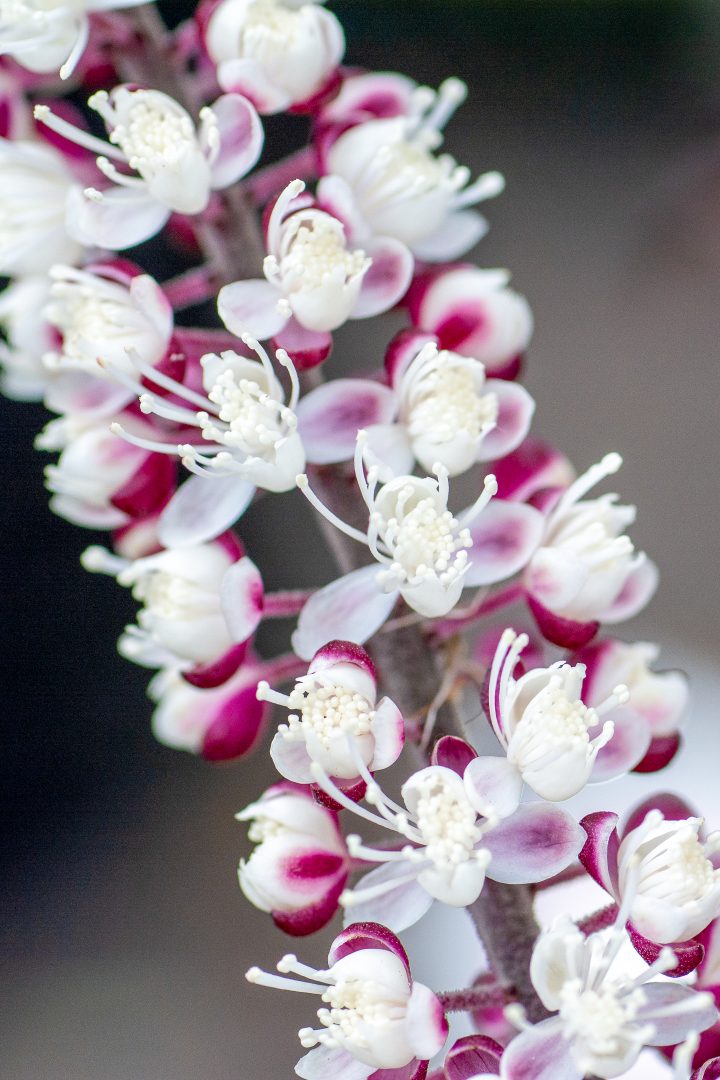
Zones: 4 to 8
Height: 36″ to 60″
Spread: 30″
Bloom Time: Late summer to fall
At 3 feet tall, or 5 feet when in bloom, with lacy foliage, Cimicifuga will provide drama and the wow factor to the late summer shady garden.
As an added bonus, the flower spires are fragrant and the plant is deer resistant.
Grow it in moist acidic soil in dappled shade.
The seedheads are interesting in the winter so wait until spring to cut the stems back.
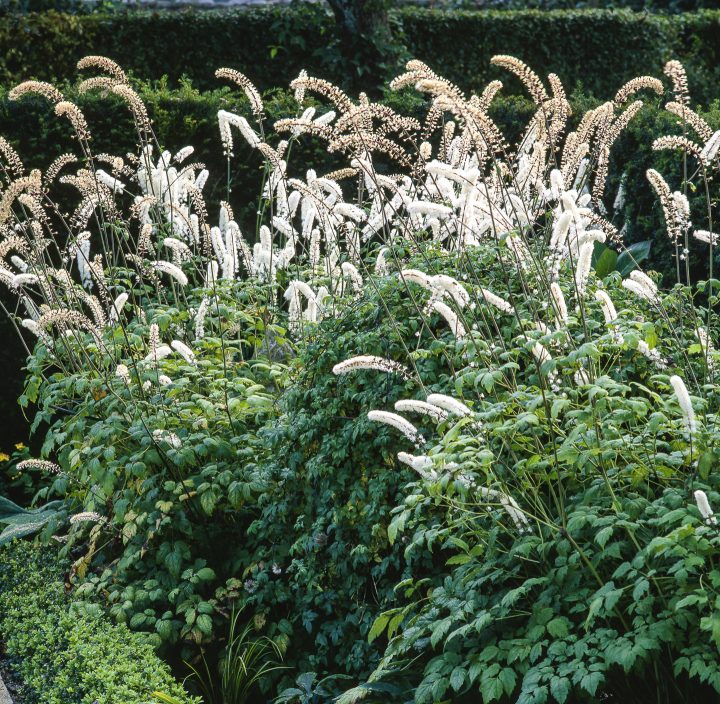
It makes a great specimen plant, or it can be planted in groups.
It takes a year for this plant to get established but once that happens it does not need dividing.
Note: The Cimicifuga plant family has recently been re-classified to the Actaea genus which is why there are so many variations of its name.
My Favorite Varieties
There are 3 varieties that have caught my attention:
A. racemosa ‘Hillside Black Beauty’ (Zone 4 – 8): Also known as Black snake root, Black bugbane, this plant has fragrant white spires in late summer and black/purple lacy leaves. Stunning, and definitely will be in my garden this spring! Get it HERE.*
A. racemosa ‘Pink Spike’ (Zone 4 – 8): Sweet-scented pink spires contrast with bronze-purple foliage. Very eye catching! Buy it HERE.*
A. racemosa ‘Chocoholic’ (Zone 4 – 8): Purple bronze leaves with white bottlebrush blooms that are fragrant and easy to grow. Find it HERE.*
2 | Bear’s Breeches (Acanthus mollis) ‘Whitewater’
Zones: 7 to 10
Height: 36″ to 48″
Spread: 36″
Bloom Time: Early to mid summer
For warmer climates, bear’s breeches will provide drama in the mostly shady border. It was bred for heat and humidity tolerance so will do well in Southern gardens.
This perennial grows 3 feet tall, with an additional foot for the creamy white, pink stemmed bloom spire.
The deeply cut serrated leaves are variegated blue-green with a white edge at maturity. They’re also evergreen and slug-resistant. Which means they will look good all year round.
This perennial grows best with morning sun and consistent moisture in well drained soil.
Remove the spent flowers after blooming and divide every 4-5 years for the healthiest plants.
It can spread by underground runners so check with local nurseries to find out if that’s a problem in your area.
3 | Japanese Anemone (Anemone huphensis)
Zones: 3 to 9 (depending on the variety)
Height: 36″
Spread: 36″
Bloom Time: Fall
Japanese anemone is one of my favorite tall shade perennials for late summer/fall blooms. It floats above the ground cover in the daintiest way as it sways in the wind.
And the multitude of cheerful pink or white flowers are always cheerful.
Japanese anemone is a late bloomer; so the plant stays dormant until late spring.
Because of this, I like to plant a fern peony beside it. The peony is fading by the time the anemone starts to sprout.
At 3′ high, this plant may need staking But it always gets many appreciative comments from passersby.
These plants also spread by underground runners and can become invasive in some areas, so check with your local nursery before planting. Or grow them in an enclosed space like a large container or raised bed.
My Favorite Varieties
Here are a couple of my favorite varieties:
A. huphensis ‘September Charm’ (Zone 4 – 8): Has beautiful pink flowers with bright yellow centers and stems that grow to be 3′ to 4′ tall. Buy it HERE.*
A. huphensis ‘Honorine Jobert’ (Zone 4 – 8): Produces beautiful white blooms with yellow stamens around chartreuse centers. It blooms prolifically in the late summer and early fall on stems that are 3′ to 4′ tall. Find it HERE.*
Learn more about growing Japanese Anemone HERE.
4 | Astilbe
Zones: 3 to 9 (depending on the variety)
Height: 18″ to 48″ (depending on the variety)
Spread: 18″
Bloom Time: Early to mid summer
Although I use dwarf Astilbe to edge shaded borders and as ground cover, there are several taller varieties that compliment hostas and do well in the shade.
Be sure to check the tags for shade tolerance, since some Astilbe actually require sun.
These perennials generally need a consistently moist soil and do best in a humus-rich environment. Thus mulching is beneficial.
It does not need dead heading. In fact, the faded plumes provide interest and bird food in the winter.
Astilbe is rabbit and deer resistant.
My Favorite Varieties
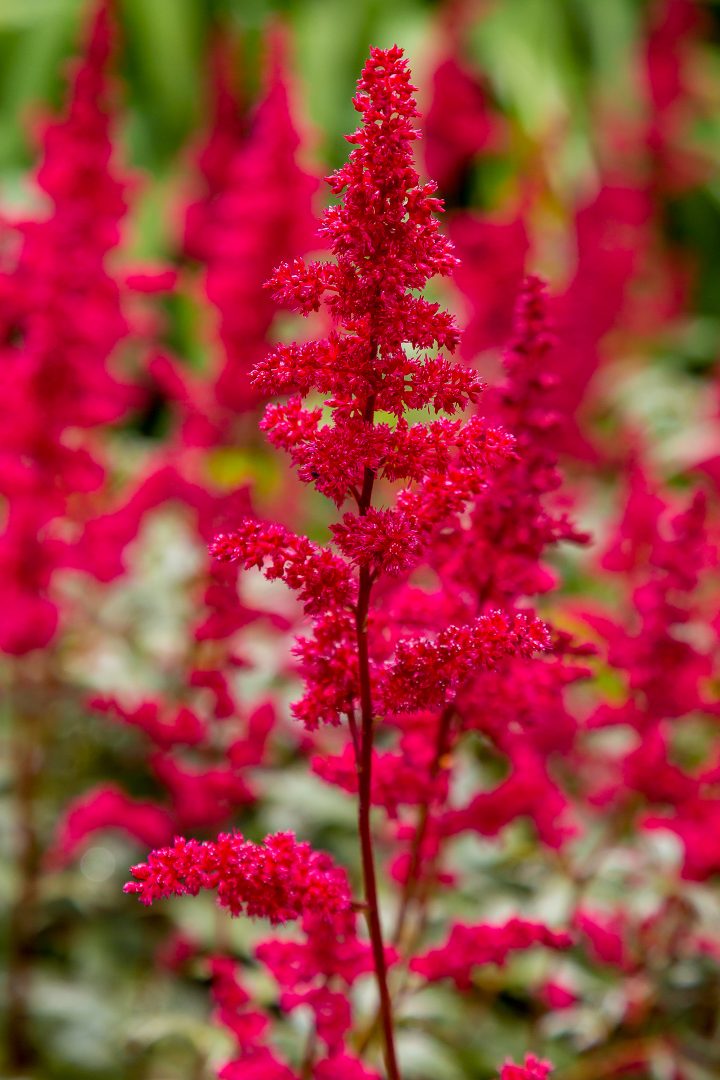
A. Japonica ‘Red Sentinel’ – pictured above (Zone 4 – 9): Nice feathery deep red flowers on a hardy plant that like shade. When it blooms in July, it will be 30 inches tall and will stand out among the surrounding plants, particularly if it is planted in multiples. Buy it HERE.*
A. arendsii ‘Amethyst’ (Zone 4 – 8): The flowers of this Astilbe are a true lilac/purple color that looks stunning in the shade. Grows to 36 inches tall. Get it HERE.*
A. arendsii ‘Chocolate Shogun’ (Zone 4 – 8): A new introduction, sporting dark glossy chocolate colored foliage and peachy/pink pentacles. This one is on my list for sure! Find it HERE.
A. chinensis ‘Black Pearls’ (Zone 3 – 8): This late bloomer has purple flowers tinged in blue that steal the show in mid to late summer. Fernlike dark green leaves keep the plant looking beautiful even when it isn’t blooming. Grows to 28 inches. Get it HERE.*
A. chinensis ‘Mighty Chocolate Cherry’ (Zone 3 – 8): The tallest astilbe at up to 4 feet with huge bright pink plumes on dark green ferny foliage. A real focal point in the woodland garden. Find it HERE.
A. ‘Fireworks Pink’ (Zone 4 – 8): New to the market this year, this compact astilbe is different from the upright habit of other astilbes, in that the peachy/pink plumes are arching. It grows 18-24 inches high and needs some sun. Imagine the thrill of seeing Fireworks pink astilbe in bloom positioned among dark wine heuchera. Gorgeous! Get it HERE.*
A. thunbergii ‘Ostrich Plume’ (Zone 4 – 8): Large weeping bright pink plumes on a plant that tolerates full shade. Buy it HERE.
5 | Goat’s Beard (Aruncus hybrid) ‘Chantilly Lace’
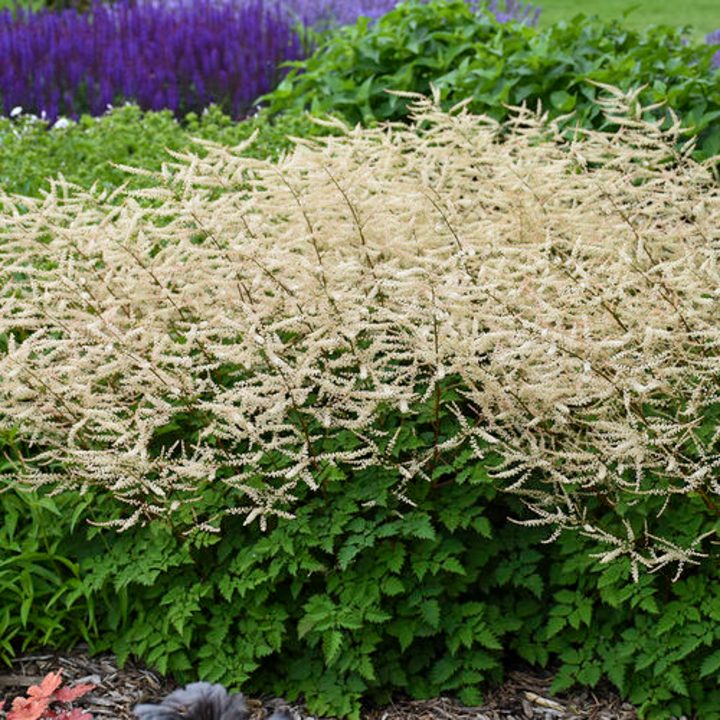
Zones: 3 to 7
Height: 30″
Spread: 40″ to 48″
Bloom Time: Late spring / Early summer
Goat’s Beard is the next tall shade perennial on my list.
It has creamy white lacy blossoms that float above delicate serrated dark green foliage on a hardy plant which thrives in full shade.
This plant looks a lot like Astilbe but it doesn’t require as much water to survive.
Goat’s Beard can take a couple of years to get going in your garden. But once it is established, it is easy to care for and covers the plant in blooms every year.
Try to plant it in its “forever home” as this perennial doesn’t like to be moved.
6 | Variegated Soloman’s seal (Polygonatum odoratum Variegatum)
Zones: 3 to 9
Height: 24″
Spread: 24″ to 30″
Bloom Time: Spring / Summer
Soloman’s seal is a shade garden classic. And this variegated variety won the Perennial Plant Association’s 2013 plant of the year award.
It has curving individual red branches from which dangle aromatic white bell-like flowers.
The white trimmed leaves stand out among surrounding shade lovers.
In the fall, the flowers turn into dark blue berries that stand out against gorgeous yellow, autumn-colored leaves.
It is a native plant that is not fussy and is easy to grow.
7 | Japanese Toad Lily (Tricyrtis hirta)
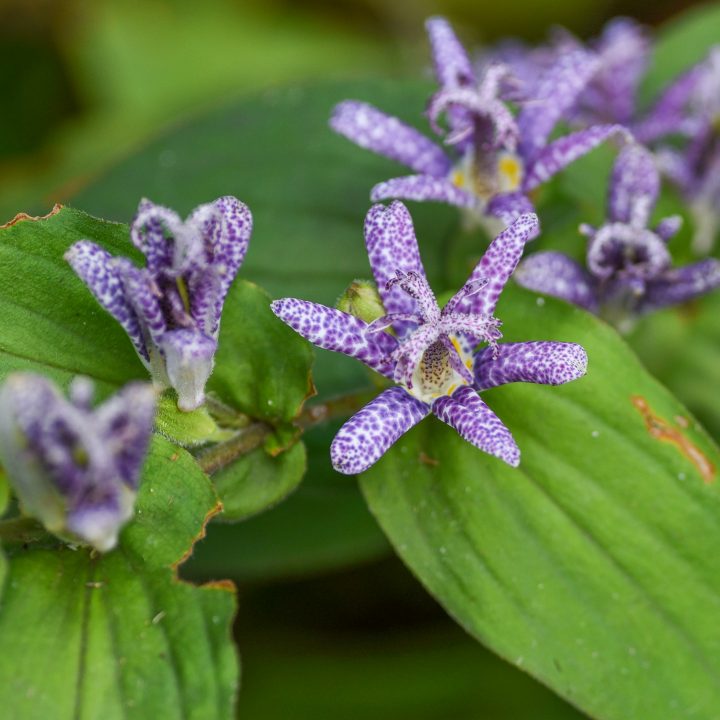
Zones: 3 to 9 (depending on the variety)
Height: 18″ to 48″ (depending on the variety)
Spread: 18″ to 24″
Bloom Time: Late summer / fall
Toad lily’s exquisite blooms are a welcome site in the fall garden.
The orchid-like flowers and the leaves are often spotted in interesting combinations of white, purple, pink, yellow, maroon and blue.
This perennial should be sited in dappled sun-light, sheltered from winds, and grown near pathways so its flowers can be seen and appreciated. Although they can be grown in a wide range of climates, they thrive in zones 5 to 7.
A member of the lily family, it comes from Asia, where it grows on the banks of streams so keep it moist for best performance and height.
Japanese Toad Lily has only been cultivated in North American gardens for the last 25 years and is still somewhat of a novelty in spite of its beauty.
Although it can be a little tricky to get started, once it’s established this is a very low maintenance plant.
It is deer resistant but rabbits will eat the leaves of some varieties.
There are a myriad of cultivars to choose from (If you’re interested, you can find an in depth description here).
My Favorite Varieties
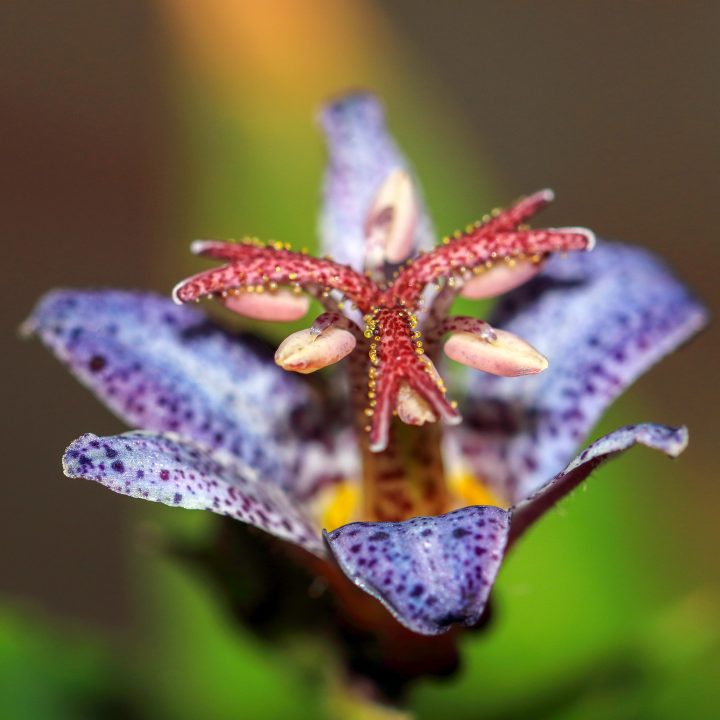
T. hirta ‘Blue Wonder’ – pictured above (Zone 4 – 8): Delicate star-shaped flowers that are white with bluish/purple spots from late summer through fall. Grows to 24″ high. Buy it HERE.
T. hirta ‘Raspberry Mousse’ (Zone 5 – 9): Rich red-purple blooms on slender stems that will be a show stopper in your shade garden. Find it HERE.*
Or try a whole collection of toad lilies for a multi-color garden (Zone 5 to 9): Get it HERE.*
8 | Leopard Plant (Ligularia dentata)
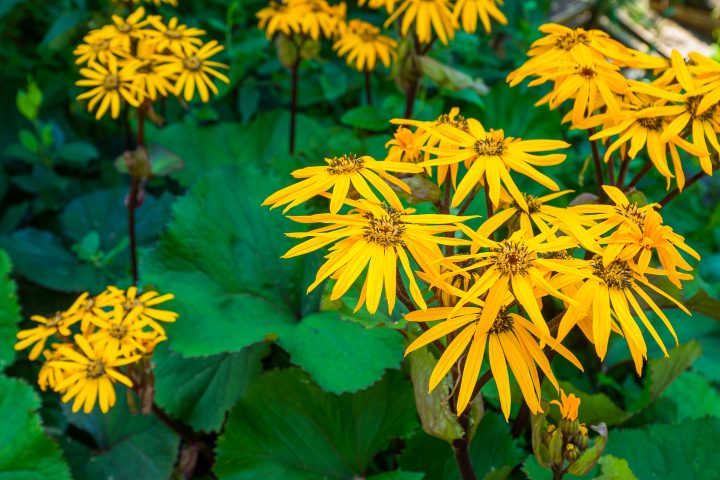
Zones: 3 to 9
Height: 24″ to 48″ (depending on the variety)
Spread: 24″ to 36″
Bloom Time: Summer
For a pop of bright color in your shade garden, this flowering perennial is just the thing.
Ligularia dentata is a large-leafed perennial that likes heavy shade and wet soil. Do not let it dry out.
This is an easy to grow plant.
The only problems being that snails and slugs will eat the leaves. And it may temporarily wilt in the afternoon sun, only to recover at night. Which makes it best sited on the north side of the house.
Ligularia also attracts bees and butterflies and resists deer.
Totally stunning if you can keep it wet enough!
My Favorite Varieties
L. dentata ‘Othello’ – pictured above (Zone 3 – 8): Green leaves that have purple undersides and purple stems with yellow flowers. Get it HERE.
L. dentata ‘Britt-Marie Crawford’ (Zone 4 – 9): Has striking huge 12″ chocolate-colored leaves that form a 3-4 foot tall clump with bright orange/yellow daisy-like flowers in early summer. Grows 36″ to 48″ tall. Buy it HERE.
L. dentata ‘BBQ Banana’ (Zone 4 – 8): Dark chocolate, green and maroon leaves contrast with the bright yellow blooms that will light up a shady spot. Grows 24″ to 36″ tall. Find it HERE.*
9 | Chinese Hardy Ground Orchid (Bletilla striata)
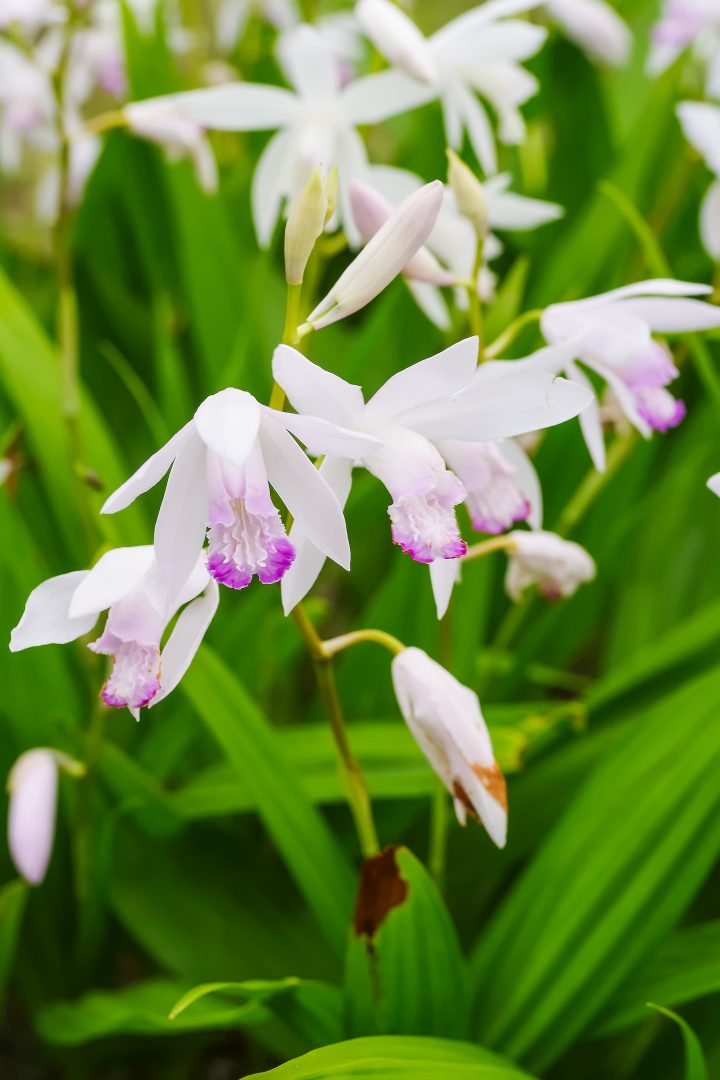
Zones: 6 to 9
Height: 20″
Spread: 12″ to 15″
Bloom Time: Late spring / early summer
If you’ve ever wanted to grow orchids in your garden but don’t live in the tropics, the next entry on my shade loving perennials list may be for you.
These Chinese hardy ground orchids are quite easy to grow and really do look like orchids.
They grow up to 24″ high (depending on the variety) and will develop many blooms per plant once they are established.
The only trouble I have with them is that rabbits really like the leaves!
10 | Monkshood (Aconitum carmichaelii ‘Arendsii’)
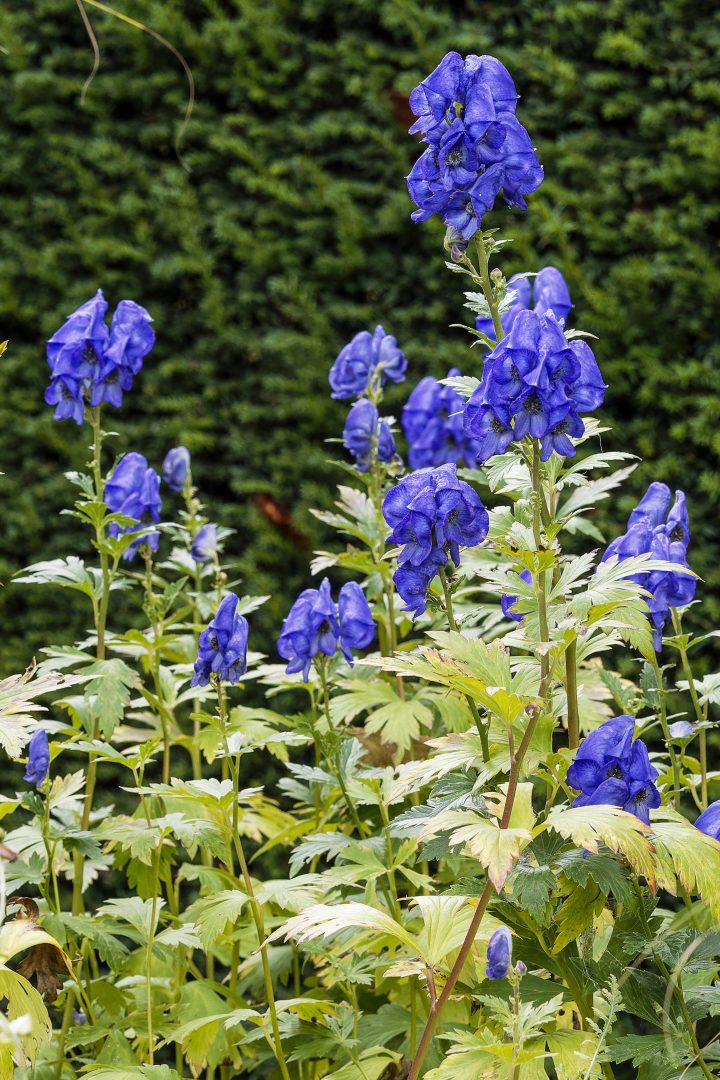
Zones: 4 to 9
Height: 48″
Spread: 15″ to 18″
Bloom Time: Late summer / fall
Monkshood is an old world perennial that has been planted in gardens for hundreds of a years.
It looks something like a delphinium with its blue flowers and cut leaf foliage.
But this variety (Aconitum carmichaelii ‘Arendsii’) has one major difference. It will grow in the shade!
Because of its height, it’s a staple in the back of shady cottage garden borders.
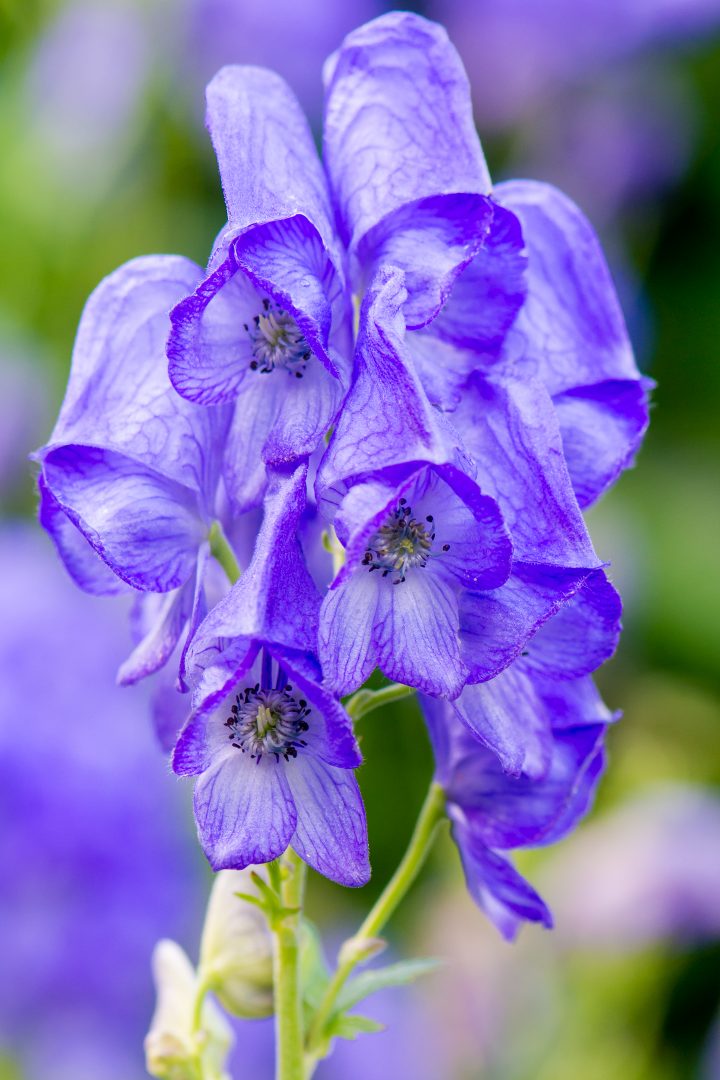
Although it is beautiful, there is one thing to be aware of: All parts of this plant are very toxic. So if you have pets or kids that could try to eat it, you will want to avoid planting it in your garden. And it’s a good idea to wear gloves while you’re handling it to prevent skin irritation.
On the positive side, being poisonous does make it very deer and rabbit resistant.
Other Shade Plants You Might Like
- Shade Loving Shrubs: 11 Beautiful Bushes To Plant Under Trees
- 21 Stunning Perennial Ground Cover Plants That Thrive in the Shade
- 15 Beautiful Deer Resistant Shade Plants To Grow In Your Garden
Do you have suggestions for other tall shade perennials with beautiful blooms? Tell us in the section below.
This post was originally published on February 7, 2020 but was updated with new content on December 30, 2023.

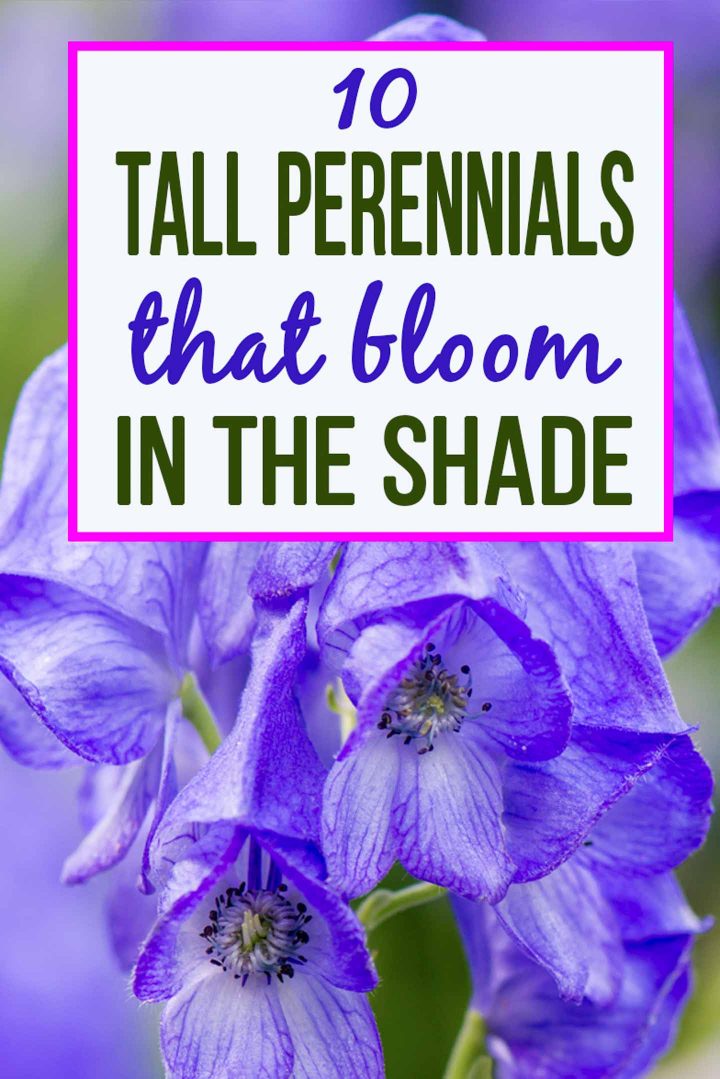


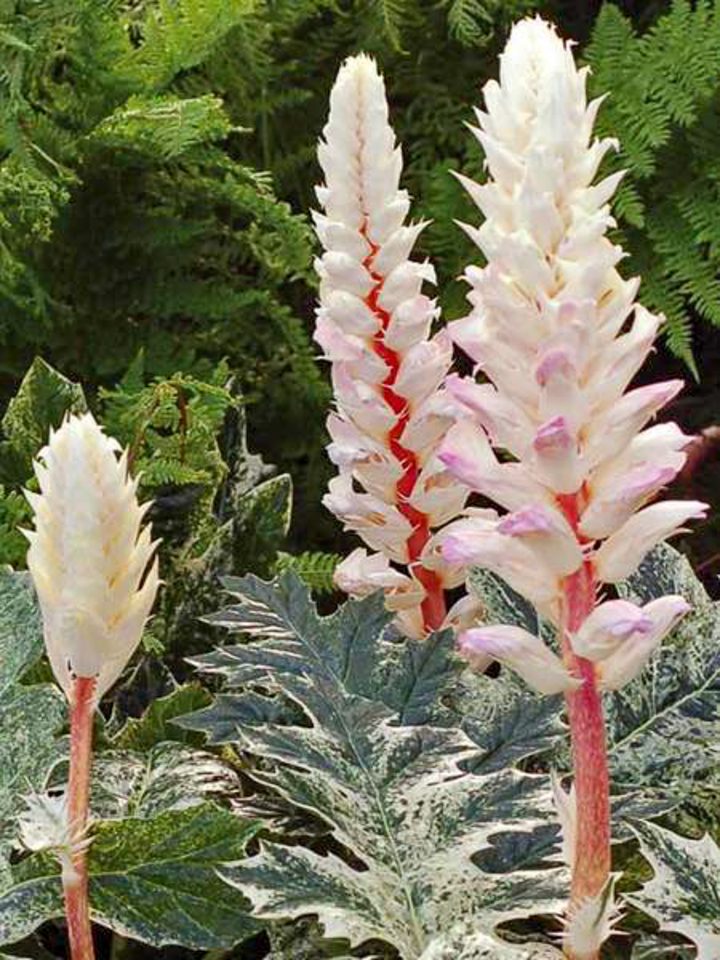






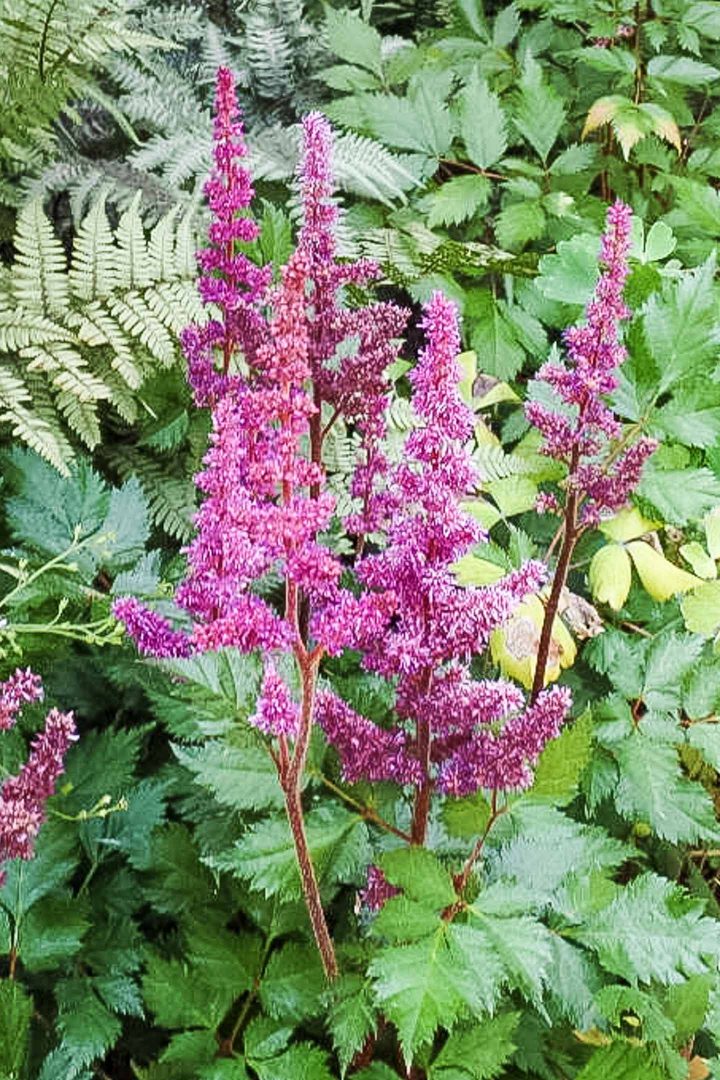
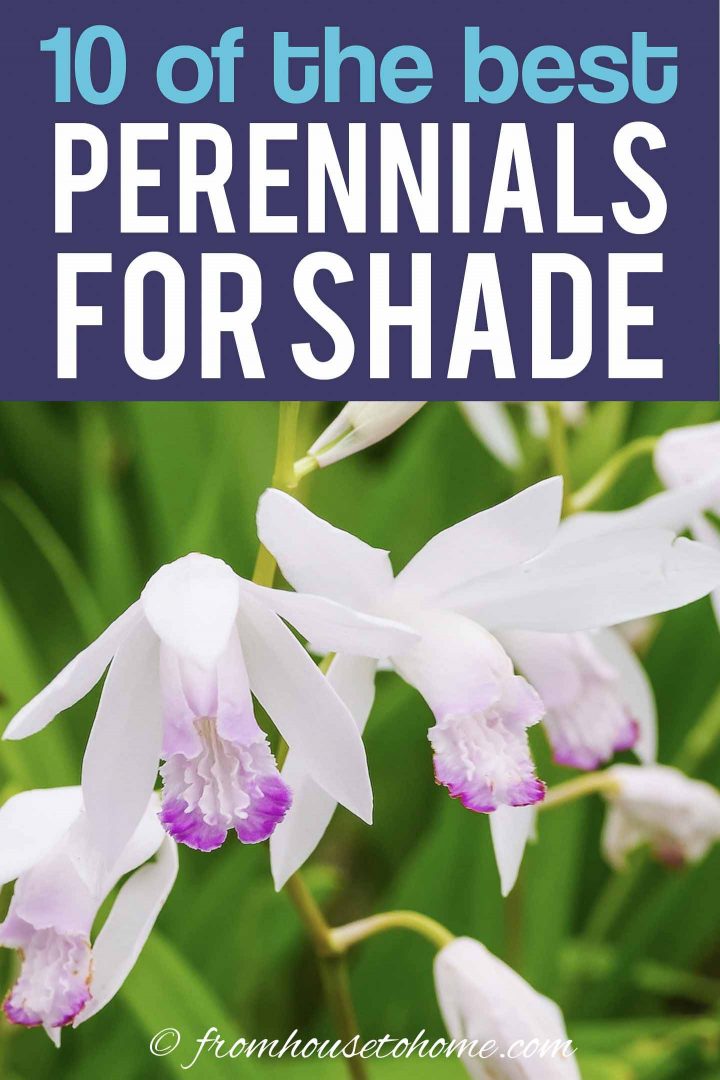
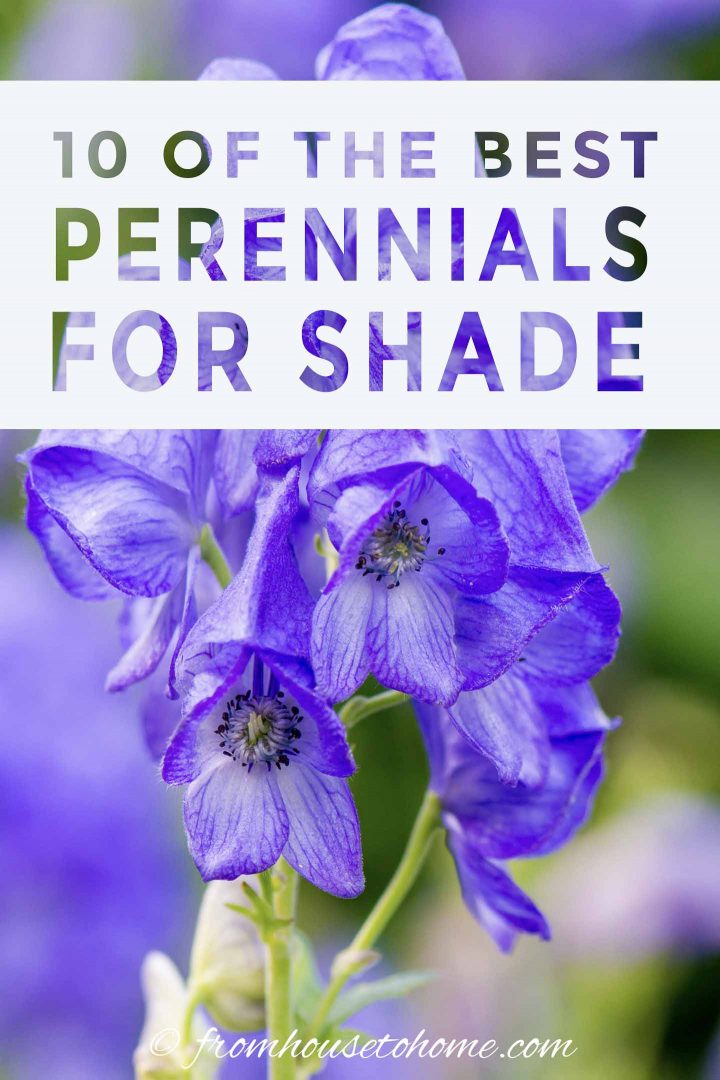
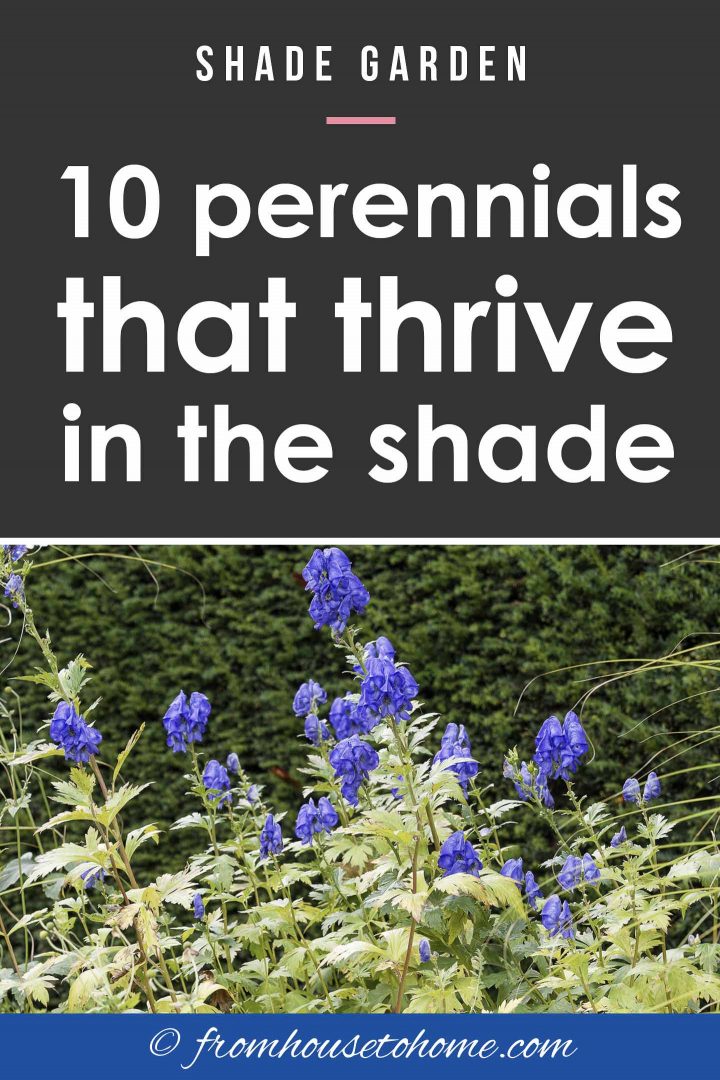
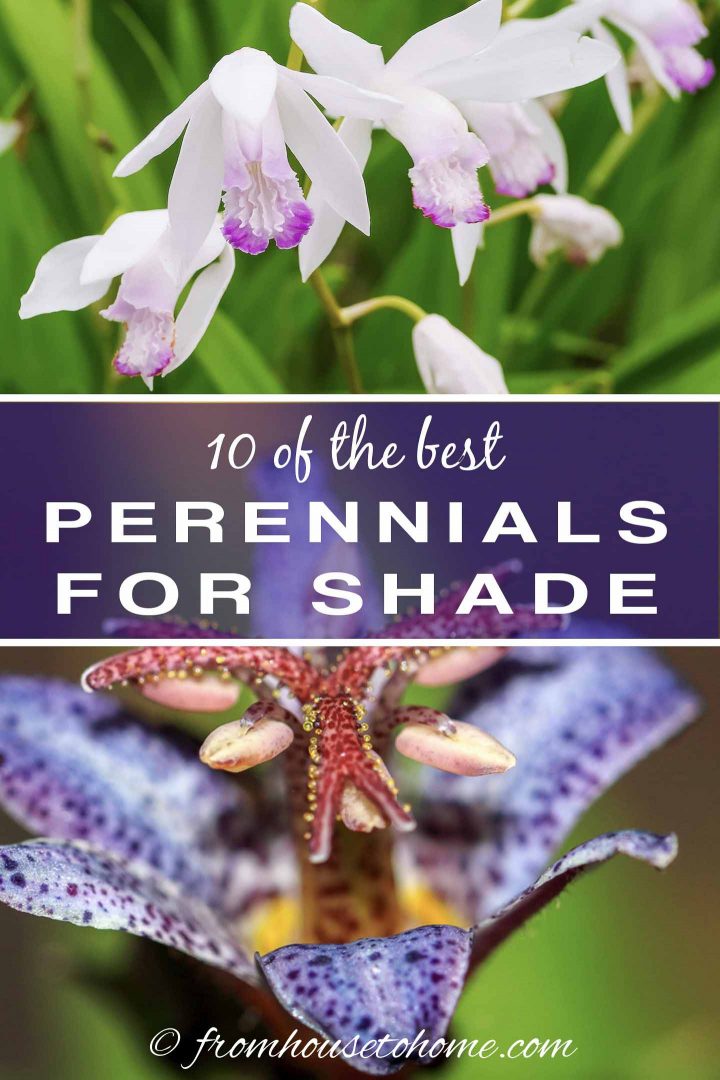
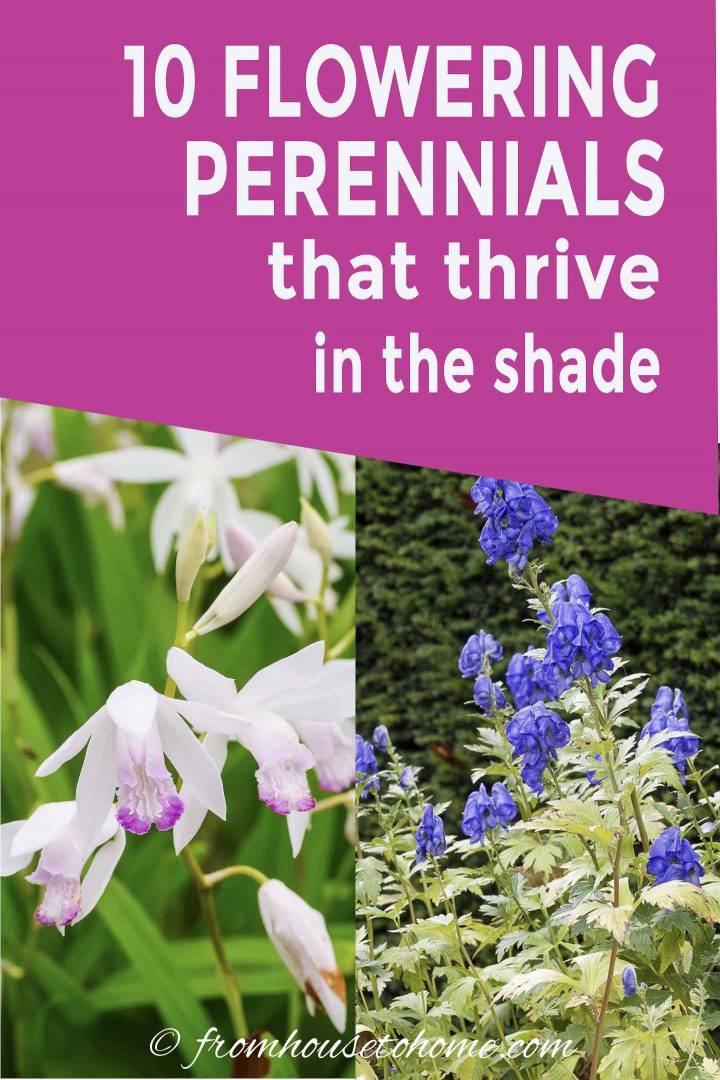
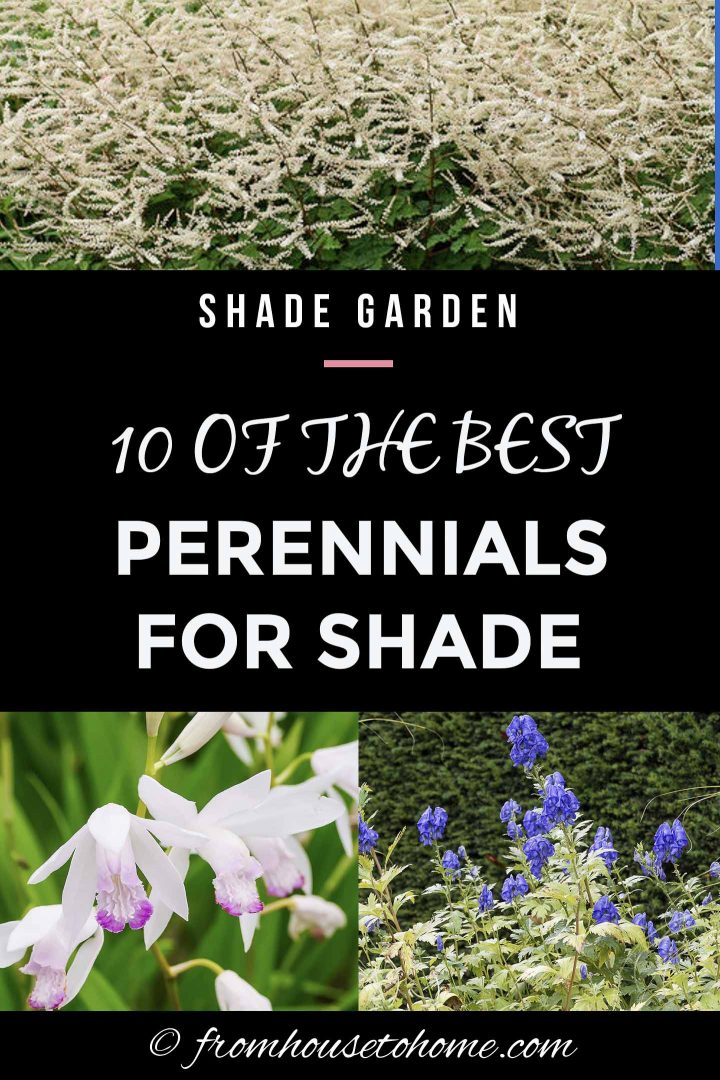
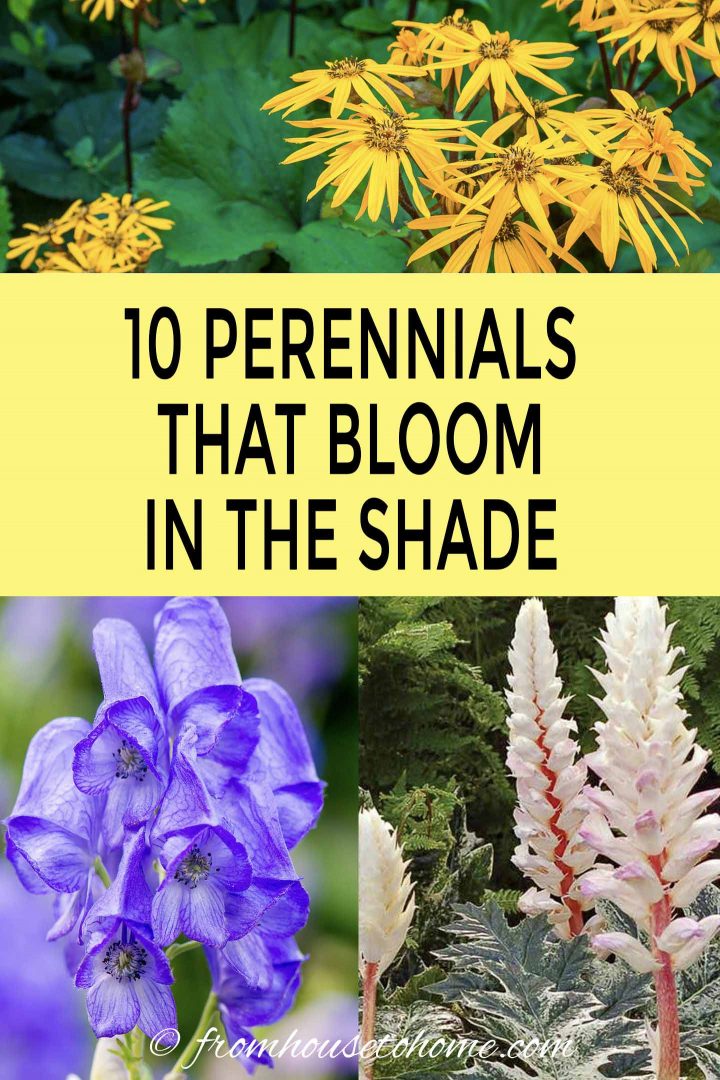
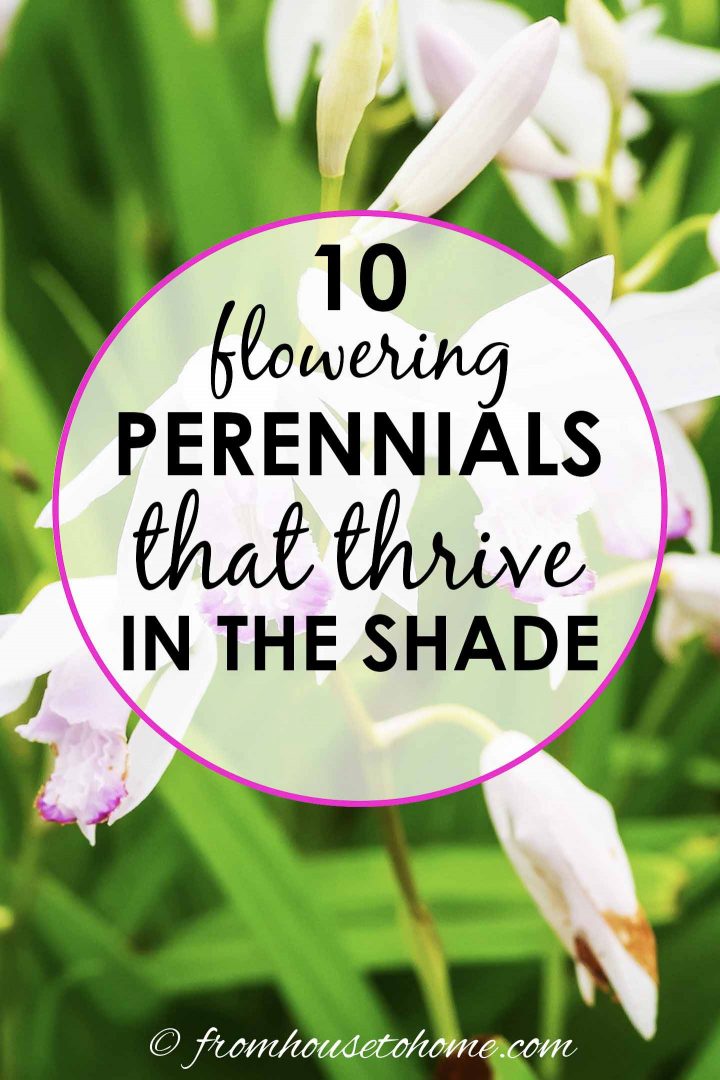
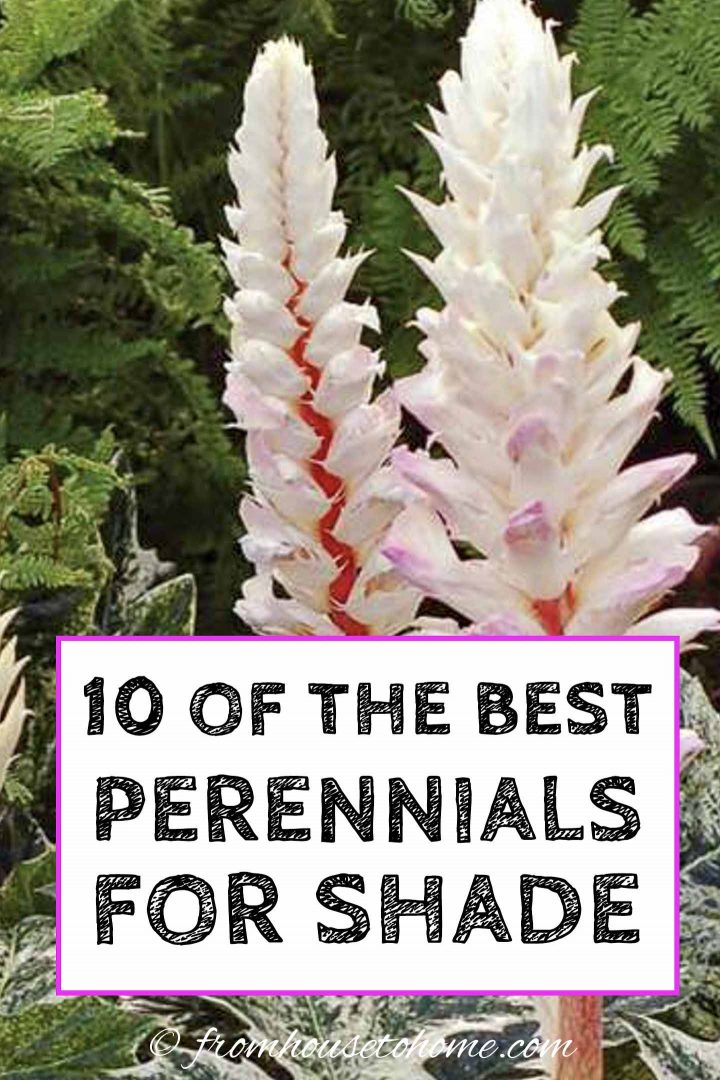
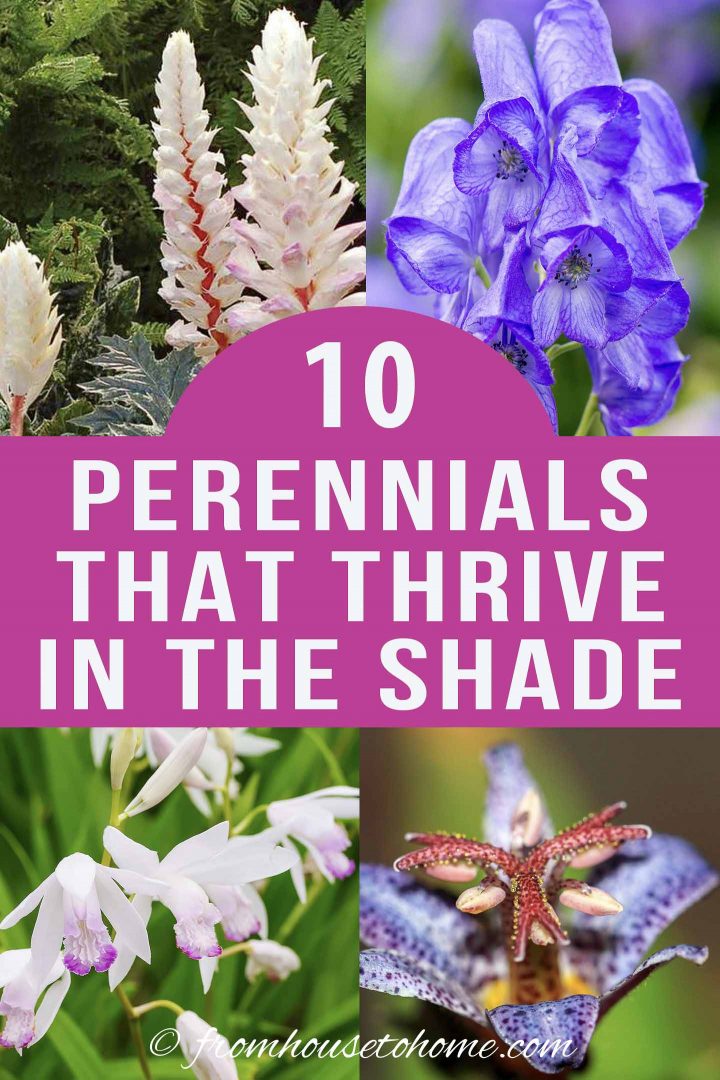
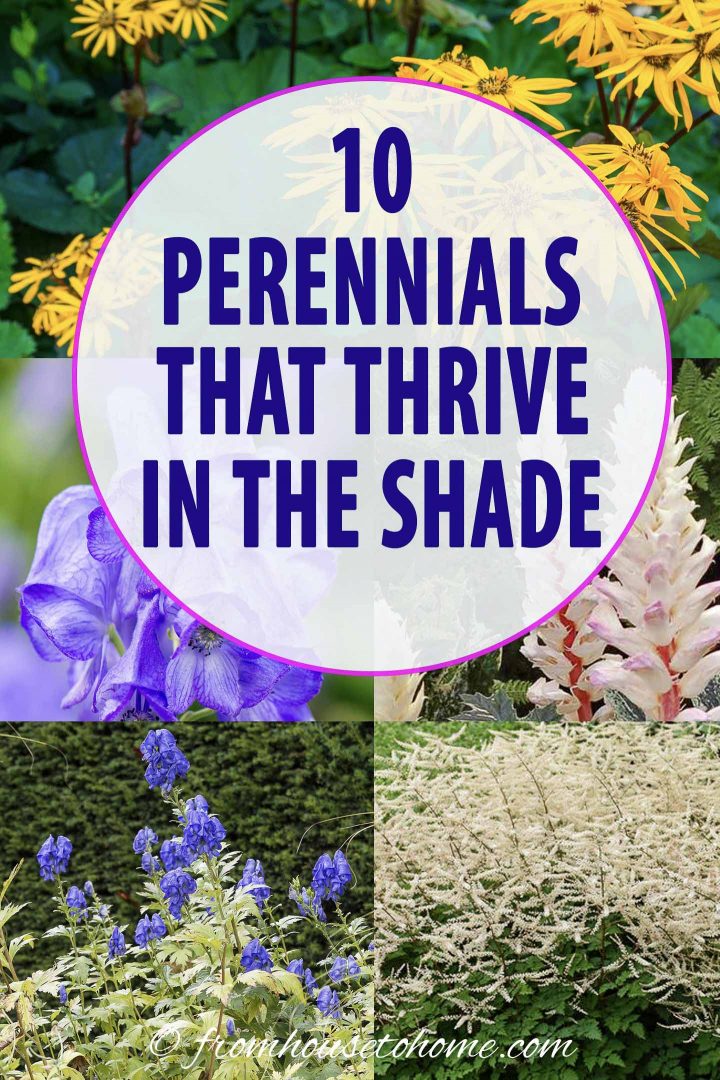
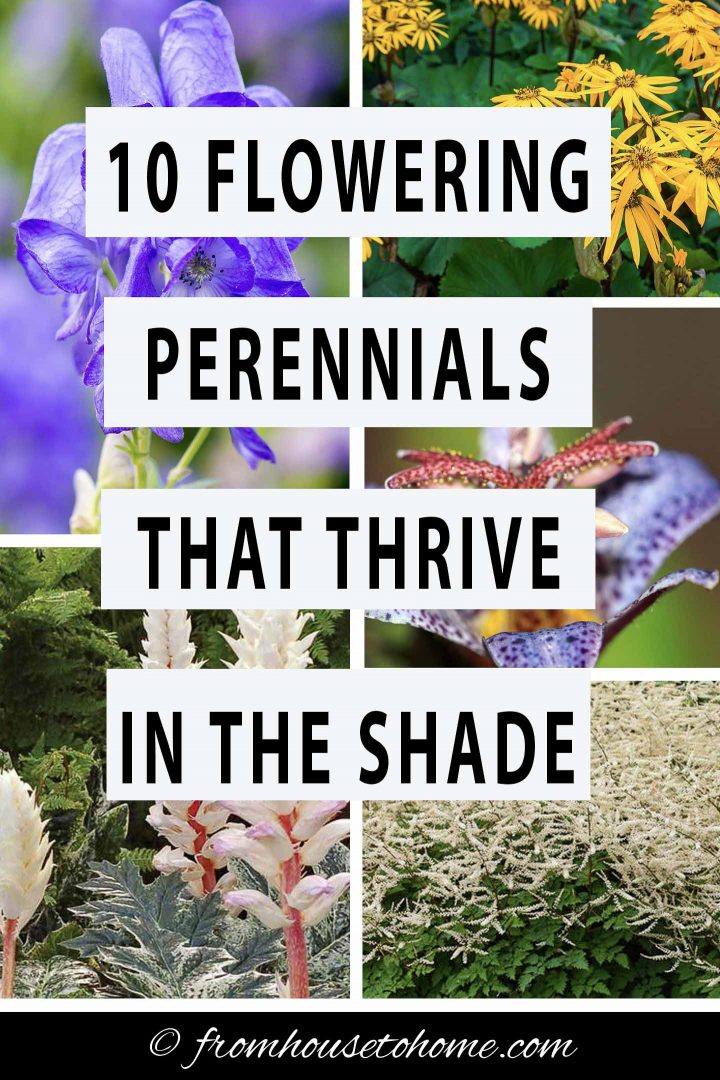
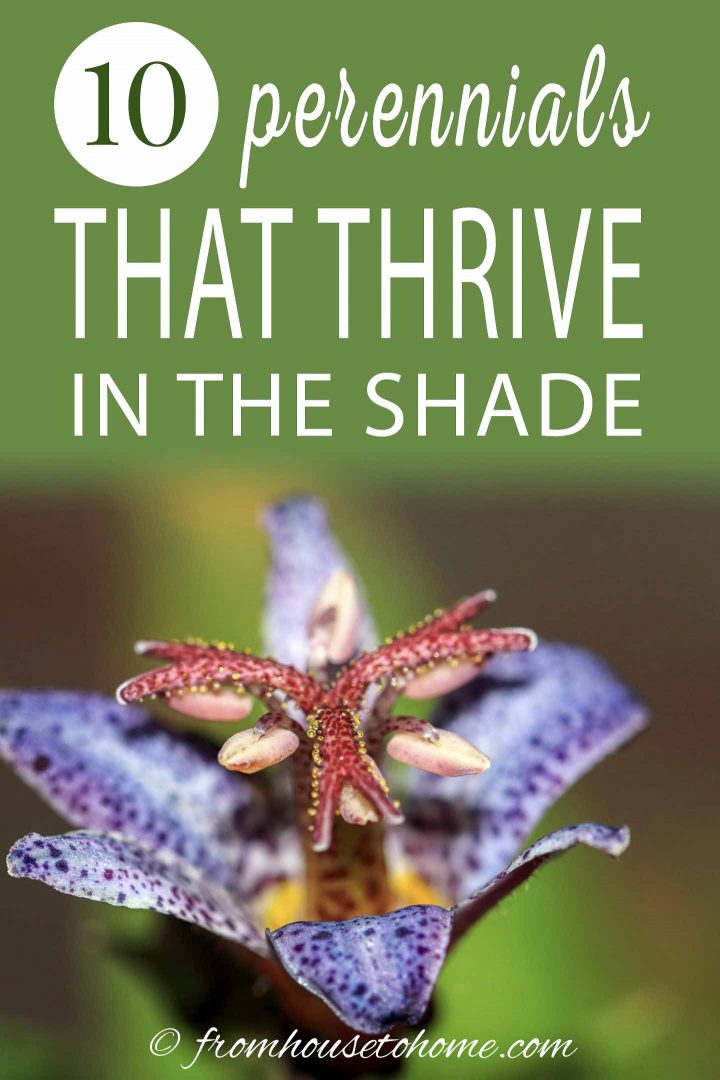
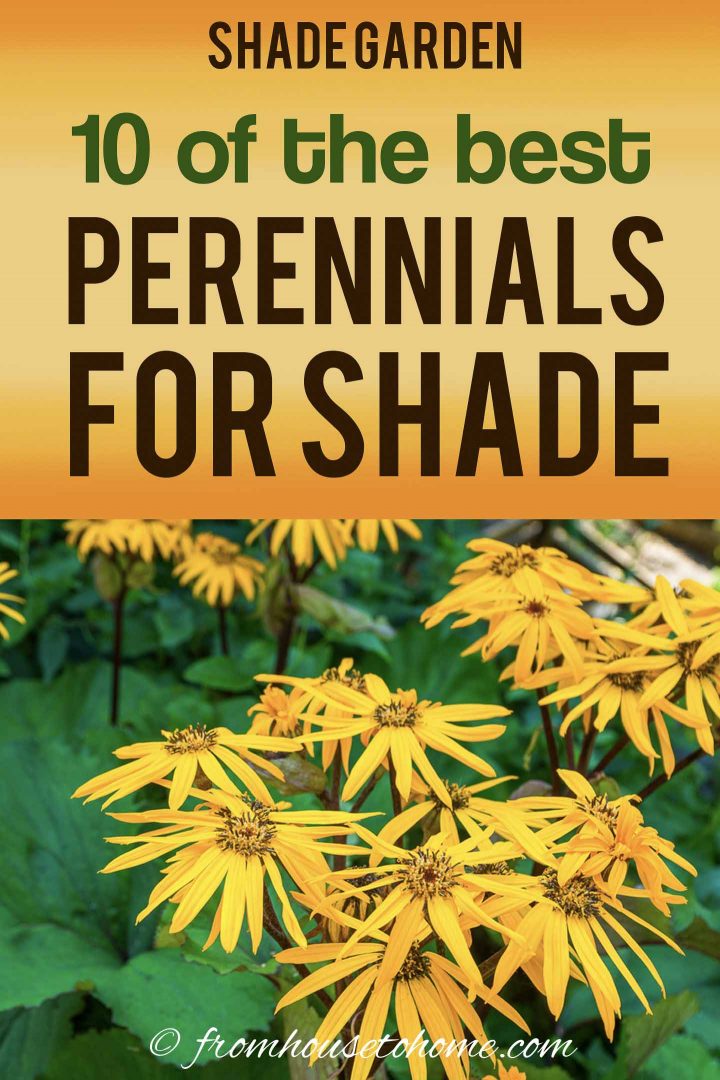
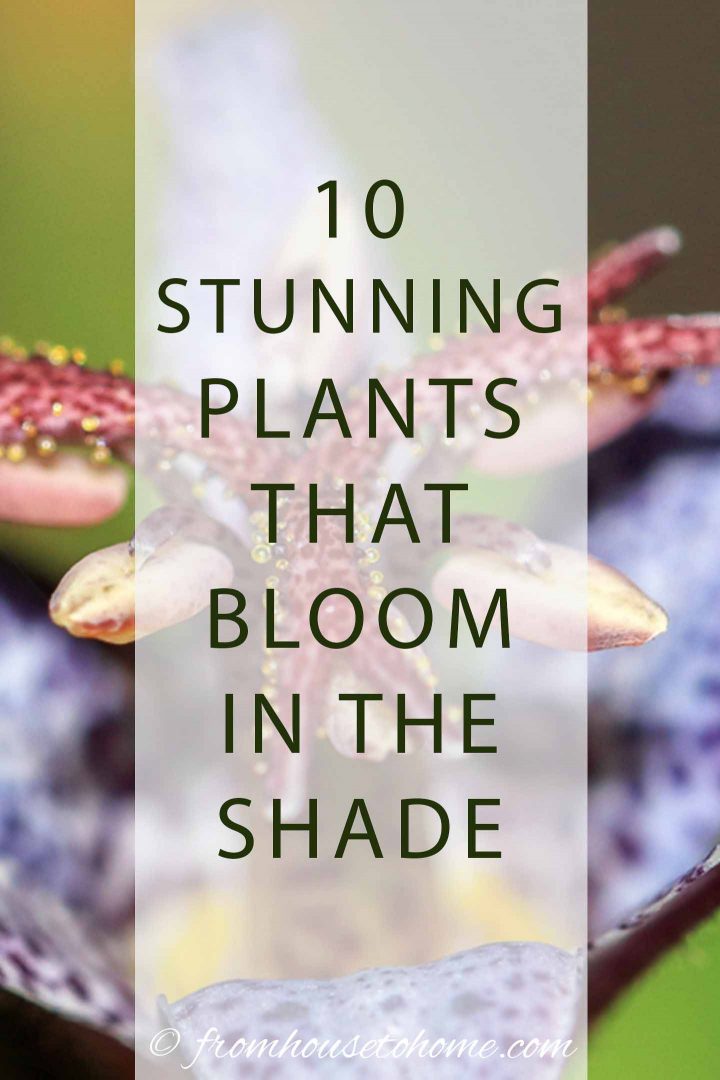
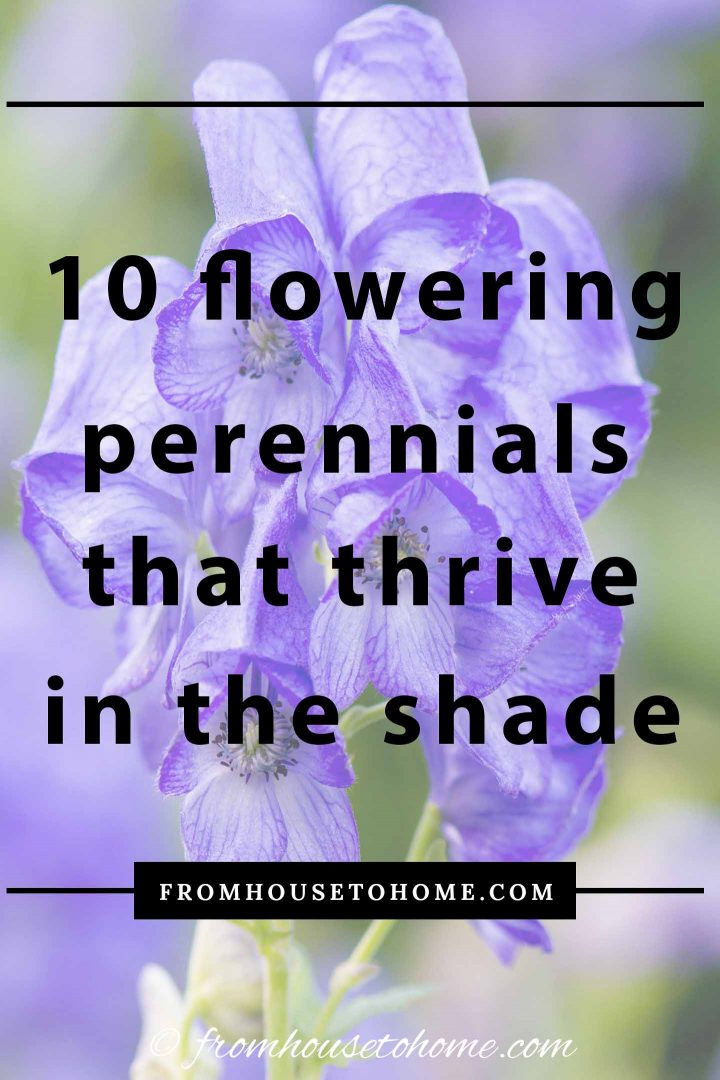
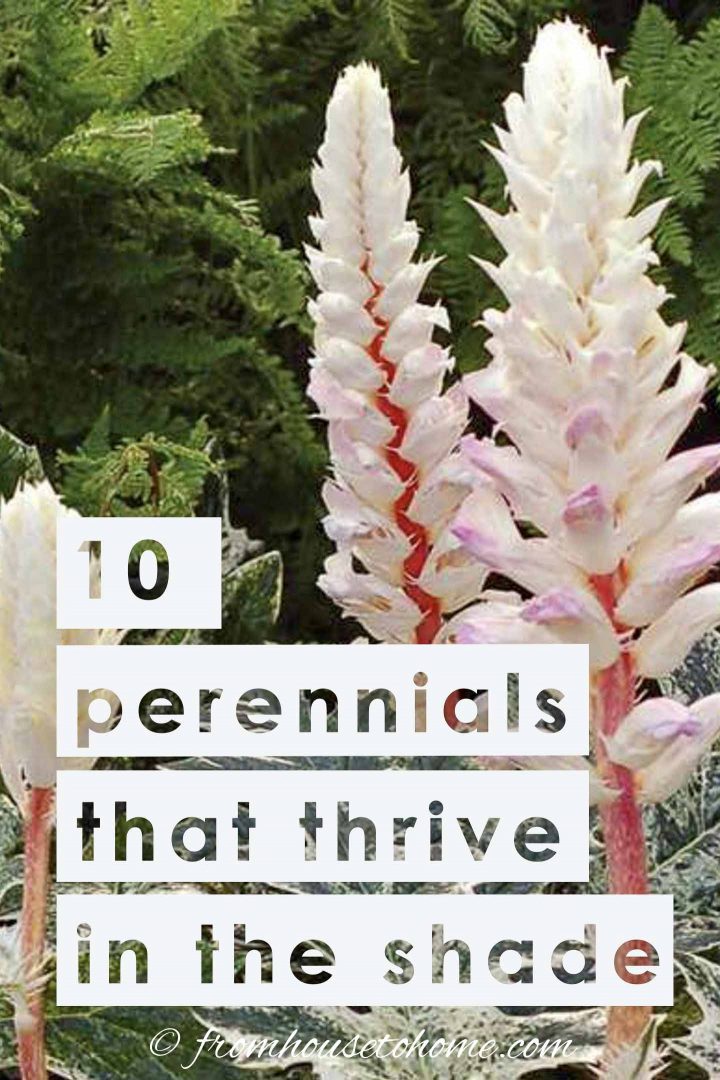
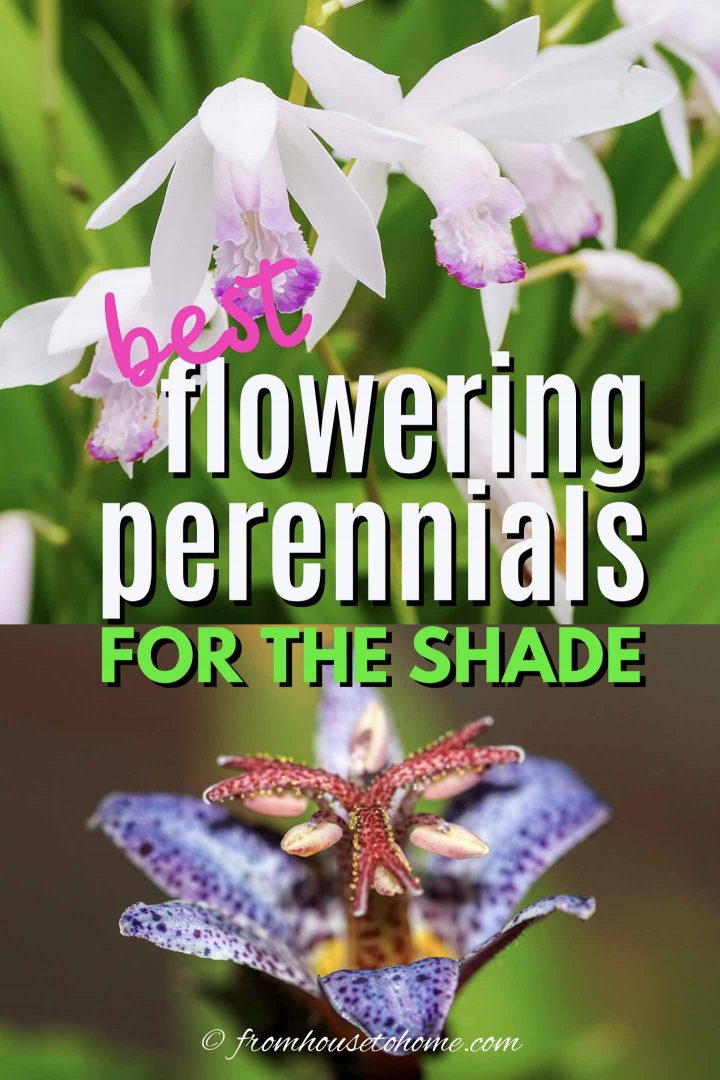
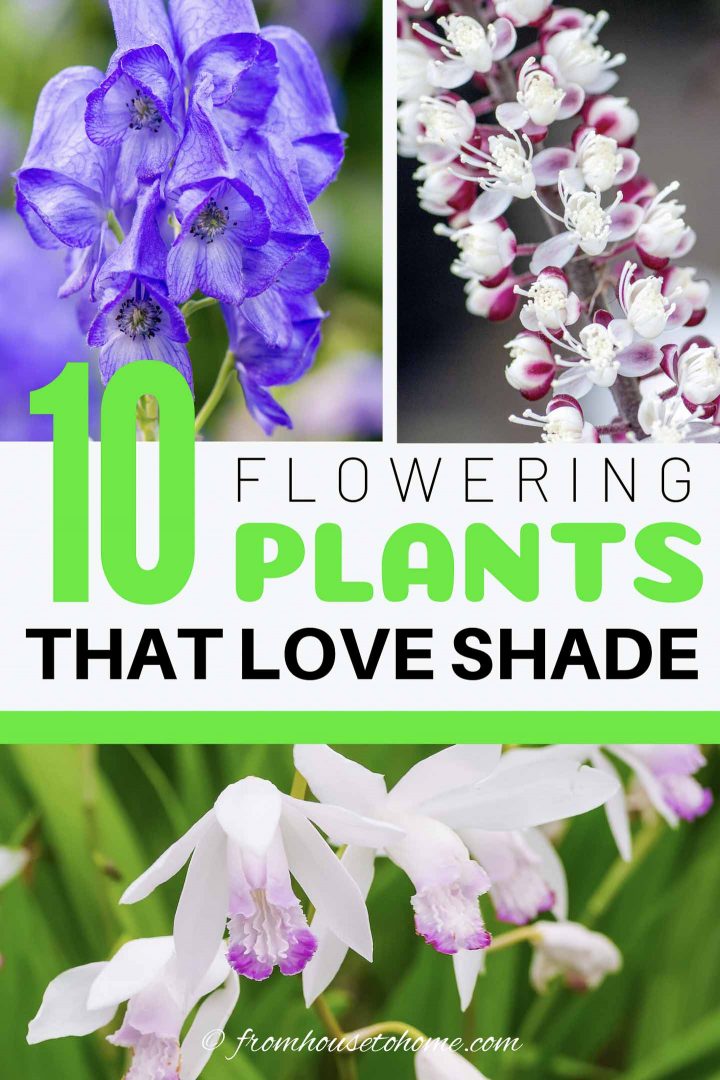


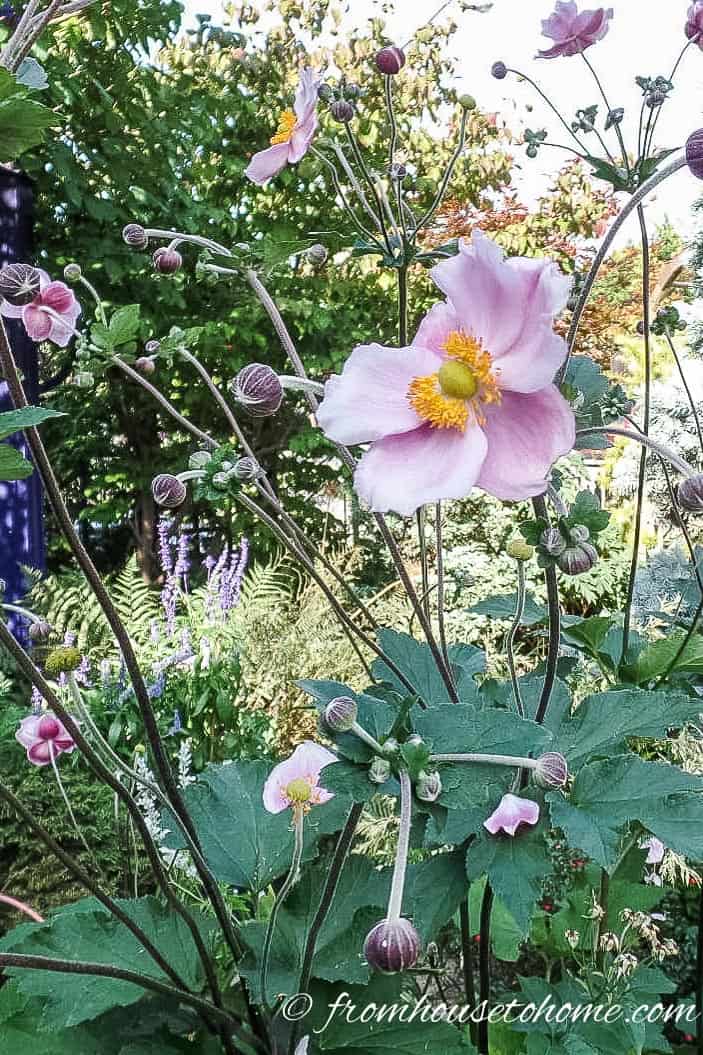
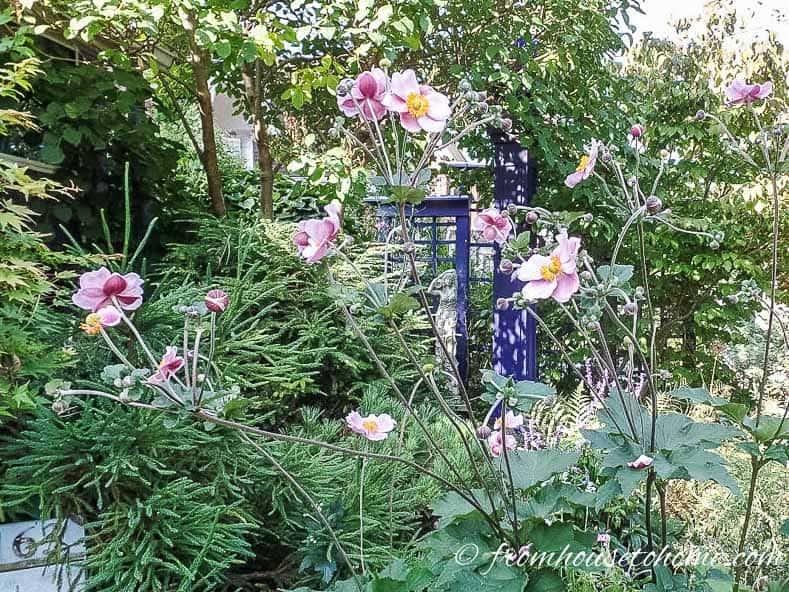
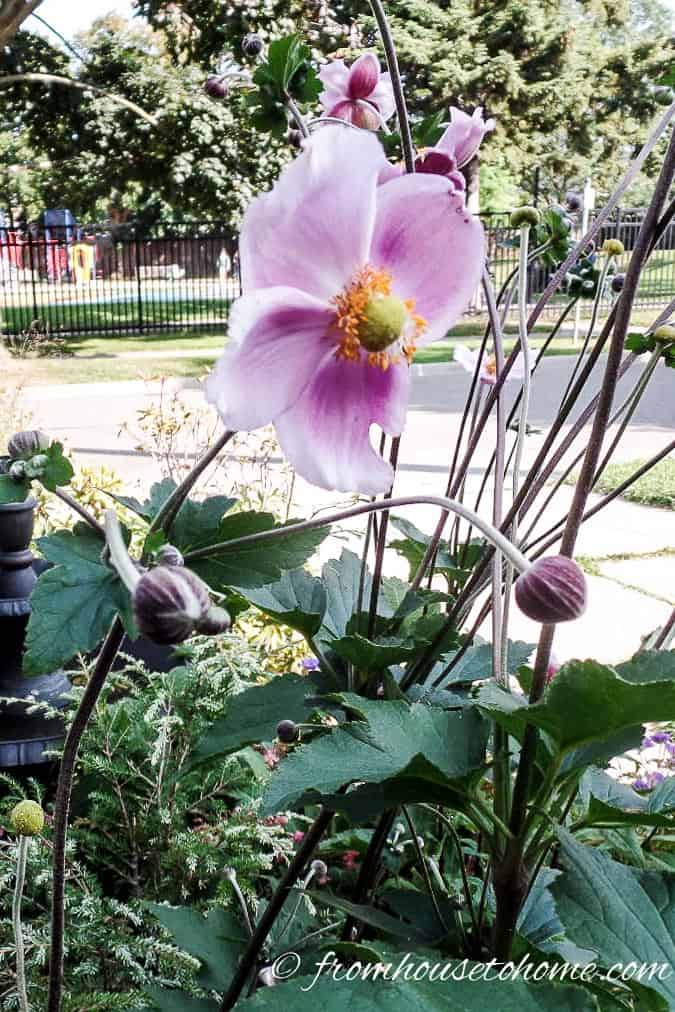

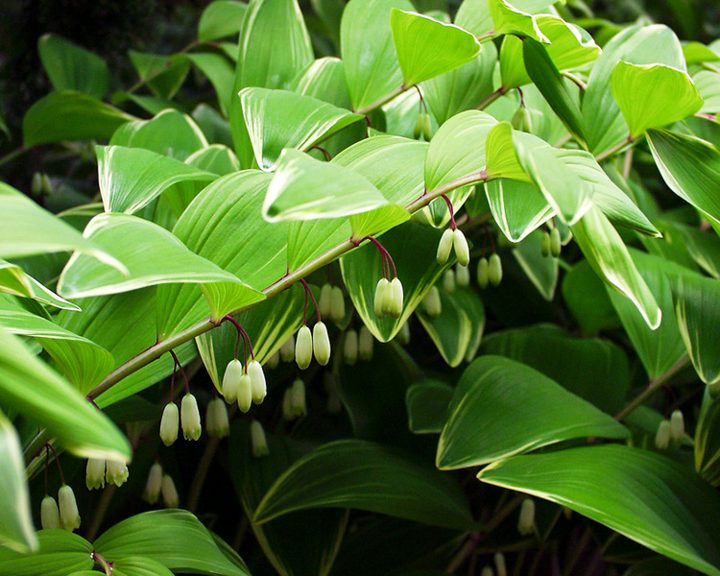
I’m loving your website!!! Such beautiful pictures even though some things I can’t grow as I am in zone 9.
I am trying to find the name of the “full shade” loving perennial with white flowers for bees and butterflies that you had on one of your lists. The variety had “Henry” in the name. Do you know what that would be?? Thanks for your help!
Hello Val, I think you are referring to Itea virginica Little Henry (Virginia Sweetspire). It is a deciduous small shrub.
Wanda – do you have any environmentally friendly suggestions to get rid of potato beatles in my garden. I have a community garden and we are not allowed to use any chemicals. Any help would be greatly appreciated. Eileen
Hi Eileen…I haven’t personally tried anything to get rid of potato beetles, but I found this article that has a few suggestions you might be able to use: https://www.planetnatural.com/pest-problem-solver/garden-pests/colorado-potato-beetle-control/
look up Japanese Beetle Trap
Hi, I appreciate the knowledge you have and shared with me. I moved to Greenville, SC. All I have in my garden is red clay. I actually dug 30 flower holes in red dirt and amended each hole with SC soil and gypsum with the red clay. They are
supertunias. It’s really at the front of my garden. Could you suggest a bush or perennial plant to replace the 30 annuals that border currently? In sun from noon on. Then I’m searching for another defining plant or shrub for along the sunny sidewalk. This garden berm is like a half moon. Thank you so much!
Thanks, Kathryn! I also live in Greenville, SC and have red clay so I know exactly what you are dealing with 🙂 For sun perennials, Daylilies, Cone Flowers, Russian sage, Creeping Phlox and Sedum grow well here (if you haven’t seen it already, there’s a list of a few more HERE). For bushes, try shrub roses, dwarf butterfly bush and rose of sharon. I hope that helps!
Thanks, Kathryn! I also live in Greenville, SC and have red clay so I know exactly what you are dealing with 🙂 For sun perennials, Daylilies, Cone Flowers, Russian sage, Creeping Phlox and Sedum grow well here (if you haven’t seen it already, there’s a list of a few more HERE). For bushes, try shrub roses, dwarf butterfly bush and rose of sharon. I hope that helps!
Thanks, Kathryn! I also live in Greenville, SC and have red clay so I know exactly what you are dealing with 🙂 For sun perennials, Daylilies, Cone Flowers, Russian sage, Creeping Phlox and Sedum grow well here (if you haven’t seen it already, there’s a list of a few more HERE). For bushes, try shrub roses, dwarf butterfly bush and rose of sharon. I hope that helps!
Thanks, Kathryn! I also live in Greenville, SC and have red clay so I know exactly what you are dealing with 🙂 For sun perennials, Daylilies, Cone Flowers, Russian sage, Creeping Phlox and Sedum grow well here (if you haven’t seen it already, there’s a list of a few more HERE). For bushes, try shrub roses, dwarf butterfly bush and rose of sharon. I hope that helps!
Thanks, Kathryn! I also live in Greenville, SC and have red clay so I know exactly what you are dealing with 🙂 For sun perennials, Daylilies, Cone Flowers, Russian sage, Creeping Phlox and Sedum grow well here (if you haven’t seen it already, there’s a list of a few more HERE). For bushes, try shrub roses, dwarf butterfly bush and rose of sharon. I hope that helps!
Thanks, Kathryn! I also live in Greenville, SC and have red clay so I know exactly what you are dealing with 🙂 For sun perennials, Daylilies, Cone Flowers, Russian sage, Creeping Phlox and Sedum grow well here (if you haven’t seen it already, there’s a list of a few more HERE). For bushes, try shrub roses, dwarf butterfly bush and rose of sharon. I hope that helps!
Thanks, Kathryn! I also live in Greenville, SC and have red clay so I know exactly what you are dealing with 🙂 For sun perennials, Daylilies, Cone Flowers, Russian sage, Creeping Phlox and Sedum grow well here (if you haven’t seen it already, there’s a list of a few more HERE). For bushes, try shrub roses, dwarf butterfly bush and rose of sharon. I hope that helps!
Thanks, Kathryn! I also live in Greenville, SC and have red clay so I know exactly what you are dealing with 🙂 For sun perennials, Daylilies, Cone Flowers, Russian sage, Creeping Phlox and Sedum grow well here (if you haven’t seen it already, there’s a list of a few more HERE). For bushes, try shrub roses, dwarf butterfly bush and rose of sharon. I hope that helps!